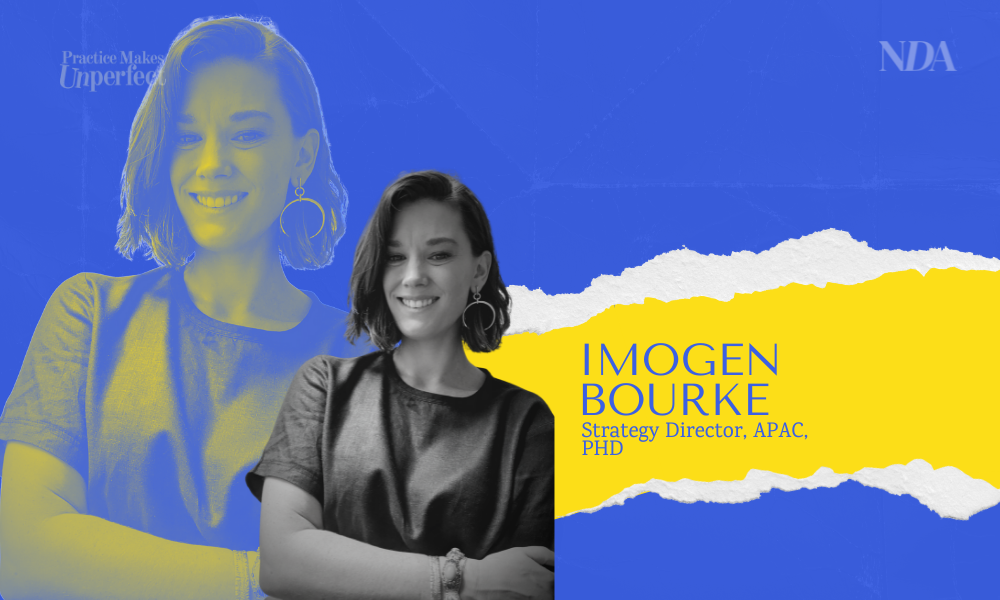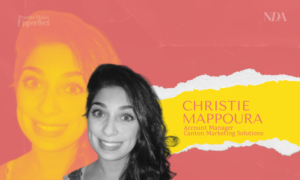By Imogen Bourke Strategy Director APAC, PHD
These articles have been written by the latest cohort of the Practice Makes UnPerfect programme – a course that helps people find and finesse their public voices
Last week, Ogilvy UK announced they will no longer accept ‘retouched’ imagery from influencers they work with, but for me a bigger question remains. When will the advertising and media industry (bar a few outliers) stop retouching the female body, and the wider female experience?
Stale gender stereotypes are still as rife as they were in the Mad Men era, with 92% of women in advertising still depicted in traditional (read: sexist) roles. Add one part ageism – only 1 in 10 ads that feature women, feature a woman over 50, two parts objectification – women are 7x more likely to be visually and verbally objectified, garnish with the most overused, uncreative trope of them all – 20% commercials depict a woman with her head thrown back laughing and you’ve got yourself an old fashioned advertising landscape Don Draper (and Ogilvy himself) would be proud of.
Still not buying? In the past 24 hours, I’ve seen a label maker and pink keyboard being spruiked as the perfect mother’s day gift (ugh), a clothing company marketing neutral green ‘outdoor adventure’ pattern as the perfect outfit for a BOY toddler (still?), and a Samsung ad that did not read the room, or indeed the unconscionable reality of women’s safety in public spaces by depicting a woman free and happy to run the streets at 2AM without bother. As one woman tweeted, “the writers of that ad have clearly never even met a woman.”
Ogilvy famously thought he did understand women when he said “the consumer isn’t a moron, she’s your wife.” Well, no. She’s a fully-realised woman. Advertising has an outsize influence in how society shapes itself. As agencies, we wax lyrical on the power and impact of brand, turning up to pitches and arming marketers with evidence demonstrating the power of creativity and brand to unlock business value and growth.
But when only 8% women feel represented in digital advertising, our report card can only read ‘room for improvement’. And there has never been a greater time for improvement (well, yesterday would have been better) but let’s ensure authentic representation of the lived female experience is included in a post-cookie, contextually rich era the advertising and media industry is entering.
We have the opportunity to create and curate environments that are safer, embrace and welcome the 93% women not currently feeling ‘seen’ in these environments (not least because they are the clear majority of purchasing decision and influence).
Yes, we are seeing tentative steps in the right direction. But the disproportionate applause and praise for ‘safe’ tactics that don’t challenge the status quo and allow us all to stay comfortable in a ‘job done’ mentality is lame. Dove’s latest campaign, #detoxyourfeed does well to dramatize and raise awareness of the dangerous impact social feeds have on young women, but really it’s still putting the labour on women and parents to do the work of dodging beauty ‘ideals’ that were crafted by the industry itself, rather than using their influence to pitch for and enact change on social platforms.
Advertising regulations around sexism and gender work and (thankfully) are finally becoming more widely adopted (Spain having just agreed to prevent toy manufactures advertising products using gender stereotypes).
In my hometown Melbourne, Australia shEqual (an alliance of media and advertising female professionals, united in their ambition to raise awareness of, educate and empower people to take action in shaping how women are represented in the stories told and consumed in Australian media) is doing great work advocating for change in advertising sexism, but it baffles me that such an easy and impactful win to adopt this as national policy has not yet occurred.
We need these easy wins on the board so we can then turn our attention to expanding these codes and ensure we are advocating positive policy change for women in digital spaces. That it took a decade to free the nipple (conditionally) on Facebook & Instagram, the fact Alexa only gained a secondary non-feminised voice in the past 12 months or most worryingly Twitter is now owned by a guy that thinks it’s LOLZ to want to start The Institute of Tech & Science, so he can go around in TITS merch, well… There’s work to be done.
For every misstep, however, we must bring greater attention to the wonderful work of women fighting sexism, stereotypes, unrealistic beauty standards, and advocating for change in the most creative of ways. I leave you with the Mums in Ads who were selling a very important hand cream for Australian Mother’s Day this past Sunday, KiraKira in Taiwan who have embraced web3/metaverse hype in the best way possible by plugging (a near universal gap) of compelling educational content in women’s reproductive health with an immersive uterus in Minecraft, or Canadian advertising creative, Victoria Lyons who I stumbled across on Linkedin recently, who has brilliantly launched her own condom brand, Slipp to meet what she (rightly) calls out as a category-wide gap in meeting hereto-women’s needs (health, discretion, pleasure) in non-hormonal contraception.
Not only do these examples embrace and deliver authenticity and promise for women, they make sound business sense. Advertising which scores high ‘unstereotype’ scores sees greater +20% ROI potential. An outcome even Ogilvy himself cannot deny.










